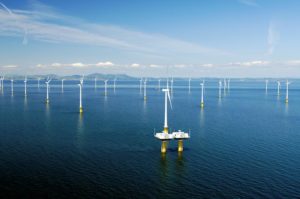
The news that Eon must foot the bill to repair defective offshore wind turbines at Robin Rigg may have ramifications for UK offshore wind farm developers.
Many developers have had to deal with issues relating to the grout used to connect turbine towers to their foundations. It’s a costly and often difficult fix in a market where the margins between financial success and failure are tight.
Grout taken out
The issue is thought to exist at around 14 UK offshore wind farms, which were built to DNV standard J101. The problem with J101 is that it significantly overestimated the tolerance of the grout, leading to movement within the foundation connections.
The Supreme Court on Friday rejected Eon’s bid to appeal an earlier ruling that its contractor, the Danish firm MT Hojgaard, was liable for repairs to the foundations at the Robin Rigg project. Hojgaard designed, fabricated and installed the turbine foundations between 2007-2009. It built them using the J101 standard before the grout problem became known.
Originally, the Technology and Construction Court ruled in Eon’s favour, before Hojgaard successfully appealed at the Court of Appeal. The dispute hinged around what had been promised in terms of warranties and how these were worded and interpreted. Now that the highest court has rejected Eon’s subsequent appeal, the matter is closed, but there may be implications for other wind farm developers in light of their own repair bills.
However, while good news for Hojgaard, the Robin Rigg case will not necessarily put contractors in the clear for working to the J101 standard. It is likely that any future cases will hinge on the contractual terms agreed by developer and contractor.
Fit for purpose provisions within absolute warranties may yet see contractors take the hit should anything go wrong. Due skill and care provisions may see developers foot the bill.
But even those provisions are not straightforward indicators of liability, as the complexity of the Robin Rigg case highlights. It also underlines how important contract drafting and terminology will be in determining just who pays for the UK to maintain the learning curve in offshore wind.
Important update: Eon’s appeal was subsequently allowed in December 2015. In August 2017, the ruling was reversed, with Eon now in the clear and contractor Hojgaard now liable.
Follow us at @EnergystMedia. For regular bulletins, sign up for the free newsletter.



